The Cambridge History of Japan, Vol. 1: Ancient Japan
Подождите немного. Документ загружается.

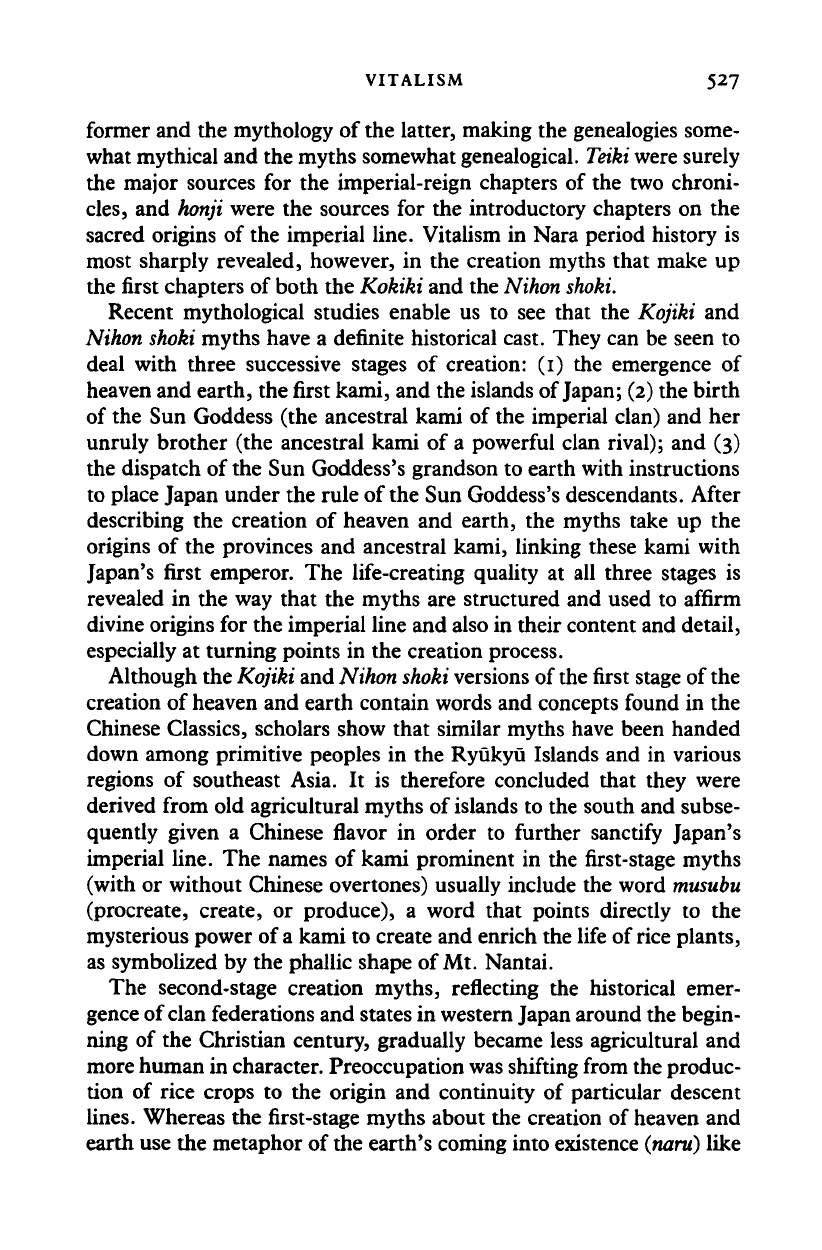
VITALISM 527
former and the mythology of the latter, making the genealogies some-
what mythical and the myths somewhat genealogical.
Teiki were
surely
the major sources for the imperial-reign chapters of the two chroni-
cles,
and
honji
were the sources for the introductory chapters on the
sacred origins of the imperial line. Vitalism in Nara period history is
most sharply revealed, however, in the creation myths that make up
the first chapters of both the Kokiki and the Nikon
shoki.
Recent mythological studies enable us to see that the Kojiki and
Nihon
shoki
myths have a definite historical cast. They can be seen to
deal with three successive stages of creation: (1) the emergence of
heaven and earth, the first kami, and the islands of Japan; (2) the birth
of the Sun Goddess (the ancestral kami of the imperial clan) and her
unruly brother (the ancestral kami of a powerful clan rival); and (3)
the dispatch of the Sun Goddess's grandson to earth with instructions
to place Japan under the rule of the Sun Goddess's descendants. After
describing the creation of heaven and earth, the myths take up the
origins of the provinces and ancestral kami, linking these kami with
Japan's first emperor. The life-creating quality at all three stages is
revealed in the way that the myths are structured and used to affirm
divine origins for the imperial line and also in their content and detail,
especially at turning points in the creation process.
Although the Kojiki and Nihon
shoki
versions of
the
first stage of the
creation of heaven and earth contain words and concepts found in the
Chinese Classics, scholars show that similar myths have been handed
down among primitive peoples in the Ryukyu Islands and in various
regions of southeast Asia. It is therefore concluded that they were
derived from old agricultural myths of islands to the south and subse-
quently given a Chinese flavor in order to further sanctify Japan's
imperial line. The names of kami prominent in the first-stage myths
(with or without Chinese overtones) usually include the word
musubu
(procreate, create, or produce), a word that points directly to the
mysterious power of
a
kami to create and enrich the life of rice plants,
as symbolized by the phallic shape of
Mt.
Nantai.
The second-stage creation myths, reflecting the historical emer-
gence of clan federations and states in western Japan around the begin-
ning of the Christian century, gradually became less agricultural and
more human in character. Preoccupation was shifting from the produc-
tion of rice crops to the origin and continuity of particular descent
lines.
Whereas the first-stage myths about the creation of heaven and
earth use the metaphor of the earth's coming into existence
(nani)
like
Cambridge Histories Online © Cambridge University Press, 2008
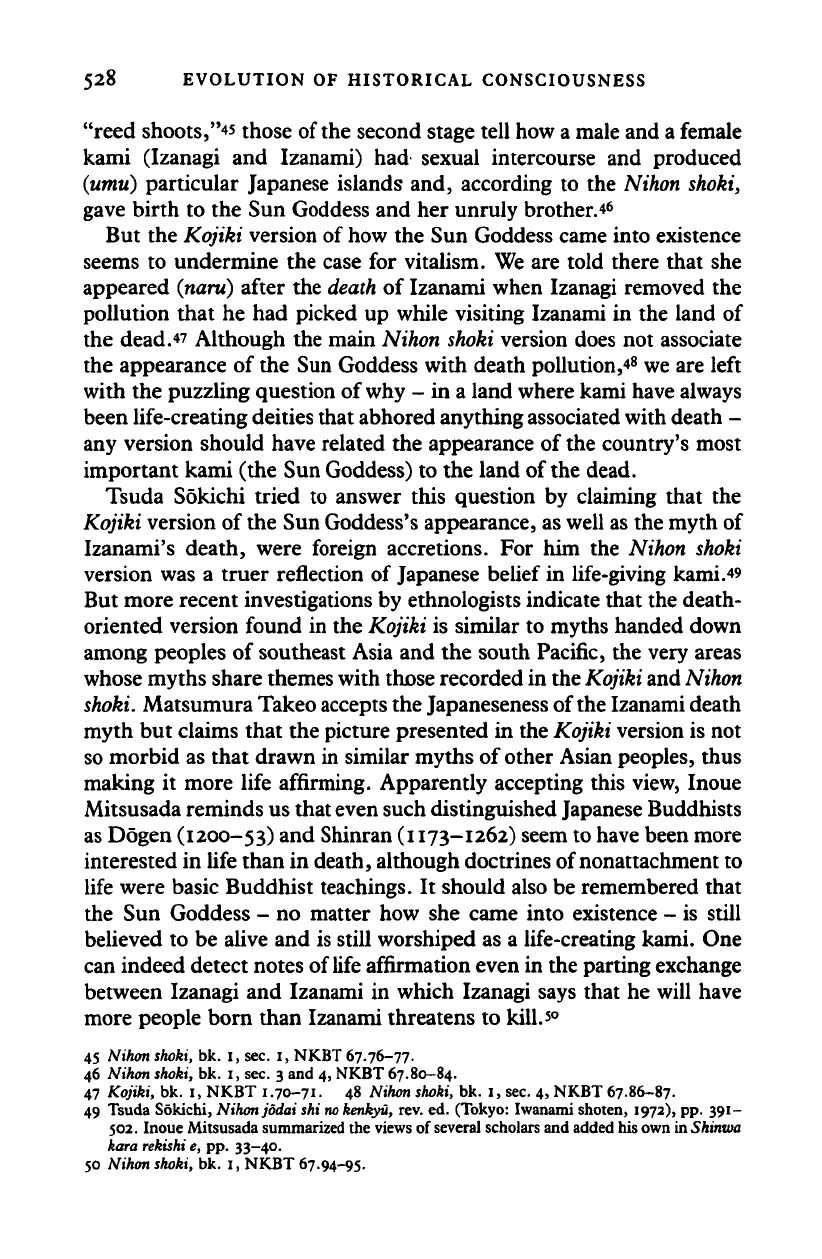
528 EVOLUTION OF HISTORICAL CONSCIOUSNESS
"reed shoots,"« those of the second stage tell how a male and a female
kami (Izanagi and Izanami) had sexual intercourse and produced
(umu) particular Japanese islands and, according to the Nihon shoki,
gave birth to the Sun Goddess and her unruly brother.
46
But the Kojiki version of how the Sun Goddess came into existence
seems to undermine the case for vitalism. We are told there that she
appeared
(naru)
after the
death
of Izanami when Izanagi removed the
pollution that he had picked up while visiting Izanami in the land of
the dead.47 Although the main Nihon
shoki
version does not associate
the appearance of the Sun Goddess with death pollution,
48
we are left
with the puzzling question of why - in a land where kami have always
been life-creating deities that abhored anything associated with death -
any version should have related the appearance of the country's most
important kami (the Sun Goddess) to the land of the dead.
Tsuda Sokichi tried to answer this question by claiming that the
Kojiki version of the Sun Goddess's appearance, as well as the myth of
Izanami's death, were foreign accretions. For him the Nihon shoki
version was a truer reflection of Japanese belief in life-giving kami.
49
But more recent investigations by ethnologists indicate that the death-
oriented version found in the Kojiki is similar to myths handed down
among peoples of southeast Asia and the south Pacific, the very areas
whose myths share themes with those recorded in
the Kojiki
and
Nihon
shoki.
Matsumura Takeo accepts the Japaneseness of the Izanami death
myth but claims that the picture presented in the Kojiki version is not
so morbid as that drawn in similar myths of other Asian peoples, thus
making it more life affirming. Apparently accepting this view, Inoue
Mitsusada reminds us that even such distinguished Japanese Buddhists
as Dogen (1200-53) and Shinran (1173-1262) seem to have been more
interested in life than in death, although doctrines of nonattachment to
life were basic Buddhist teachings. It should also be remembered that
the Sun Goddess - no matter how she came into existence - is still
believed to be alive and is still worshiped as a life-creating kami. One
can indeed detect notes of life affirmation even in the parting exchange
between Izanagi and Izanami in which Izanagi says that he will have
more people born than Izanami threatens to kill.'
0
45 Nihon shoki, bk. I, sec. I, NKBT 67.76-77.
46 Nihon shoki, bk. 1, sec. 3 and 4, NKBT 67.80-84.
47 Kojiki, bk. 1, NKBT 1.70-71. 48 Nihon shoki, bk. 1, sec. 4, NKBT 67.86-87.
49 Tsuda Sokichi, Nihon jodai shi
no
kenkyu,
rev. ed. (Tokyo: Iwanami shoten, 1972), pp. 391-
502.
Inoue Mitsusada summarized the views of several scholars and added his own in Shinwa
kara rekishi e, pp. 33-40.
50 Nihon shoki, bk. 1, NKBT 67.94-95.
Cambridge Histories Online © Cambridge University Press, 2008
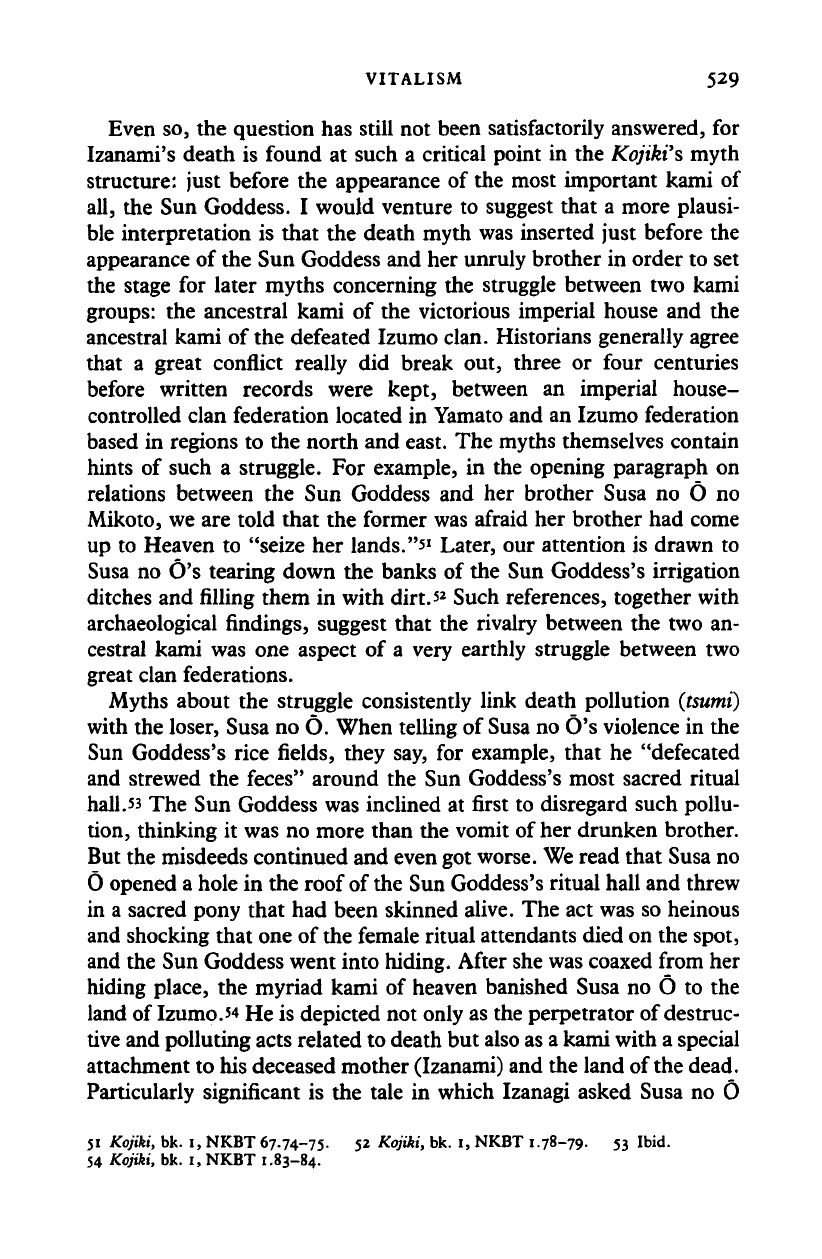
VITALISM 529
Even so, the question has still not been satisfactorily answered, for
Izanami's death is found at such a critical point in the Kojiki's myth
structure: just before the appearance of the most important kami of
all,
the Sun Goddess. I would venture to suggest that a more plausi-
ble interpretation is that the death myth was inserted just before the
appearance of the Sun Goddess and her unruly brother in order to set
the stage for later myths concerning the struggle between two kami
groups: the ancestral kami of the victorious imperial house and the
ancestral kami of the defeated Izumo clan. Historians generally agree
that a great conflict really did break out, three or four centuries
before written records were kept, between an imperial house-
controlled clan federation located in Yamato and an Izumo federation
based in regions to the north and east. The myths themselves contain
hints of such a struggle. For example, in the opening paragraph on
relations between the Sun Goddess and her brother Susa no O no
Mikoto, we are told that the former was afraid her brother had come
up to Heaven to "seize her lands."s
1
Later, our attention is drawn to
Susa no O's tearing down the banks of the Sun Goddess's irrigation
ditches and filling them in with dirt.*
2
Such references, together with
archaeological findings, suggest that the rivalry between the two an-
cestral kami was one aspect of a very earthly struggle between two
great clan federations.
Myths about the struggle consistently link death pollution (tsumi)
with the loser, Susa no O. When telling of Susa no O's violence in the
Sun Goddess's rice fields, they say, for example, that he "defecated
and strewed the feces" around the Sun Goddess's most sacred ritual
hall.53 The Sun Goddess was inclined at first to disregard such pollu-
tion, thinking it was no more than the vomit of her drunken brother.
But the misdeeds continued and even got worse. We read that Susa no
O opened a hole in the roof of the Sun Goddess's ritual hall and threw
in a sacred pony that had been skinned alive. The act was so heinous
and shocking that one of the female ritual attendants died on the spot,
and the Sun Goddess went into hiding. After she was coaxed from her
hiding place, the myriad kami of heaven banished Susa no O to the
land of Izumo.» He is depicted not only as the perpetrator of destruc-
tive and polluting acts related to death but also as a kami with a special
attachment to his deceased mother (Izanami) and the land of the dead.
Particularly significant is the tale in which Izanagi asked Susa no 0
51 Kojiki, bk. 1, NKBT 67.74-75- 5* Kojiki, bk. 1, NKBT 1.78-79- 53 Ibid.
54 Kojiki, bk. 1, NKBT 1.83-84.
Cambridge Histories Online © Cambridge University Press, 2008
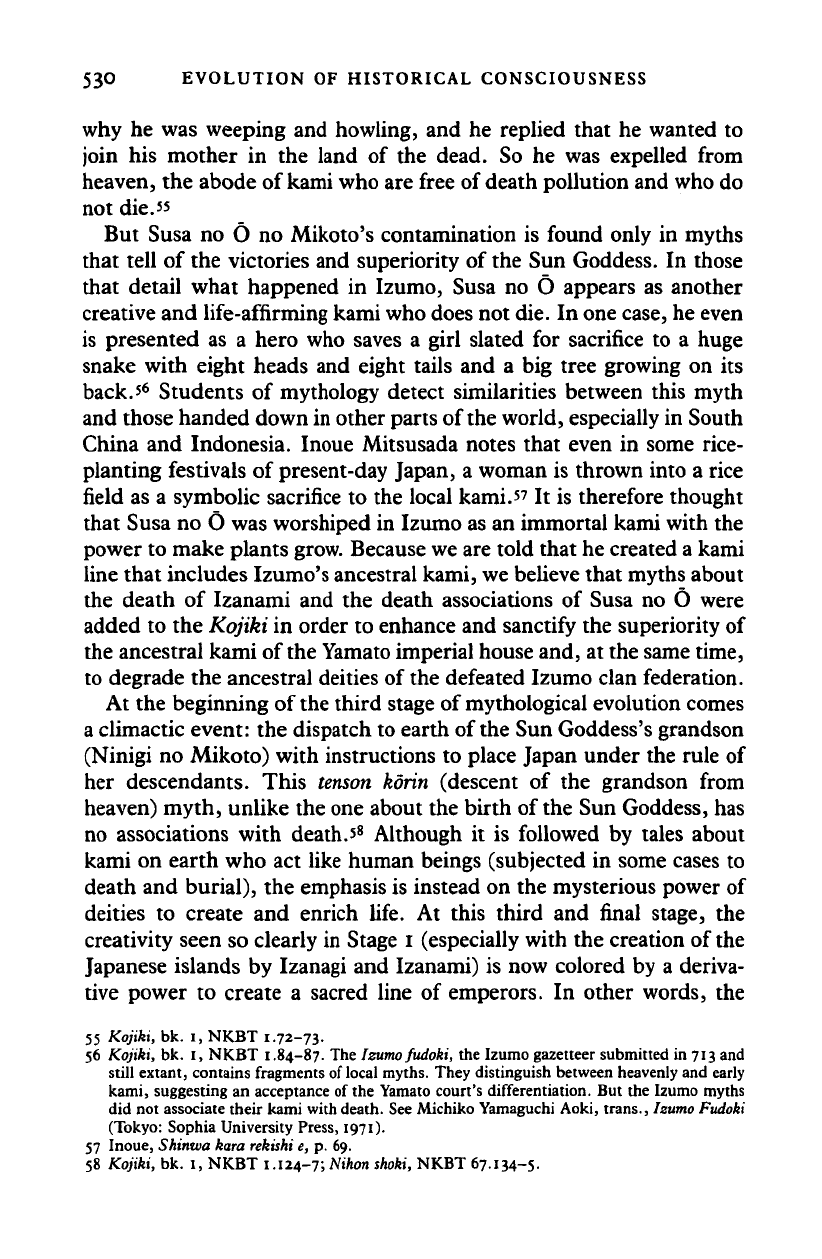
530 EVOLUTION OF HISTORICAL CONSCIOUSNESS
why he was weeping and howling, and he replied that he wanted to
join his mother in the land of the dead. So he was expelled from
heaven, the abode of
kami
who are free of death pollution and who do
not die.55
But Susa no O no Mikoto's contamination is found only in myths
that tell of the victories and superiority of the Sun Goddess. In those
that detail what happened in Izumo, Susa no O appears as another
creative and life-affirming kami who does not die. In one case, he even
is presented as a hero who saves a girl slated for sacrifice to a huge
snake with eight heads and eight tails and a big tree growing on its
back.5
6
Students of mythology detect similarities between this myth
and those handed down in other parts of the world, especially in South
China and Indonesia. Inoue Mitsusada notes that even in some rice-
planting festivals of present-day Japan, a woman is thrown into a rice
field as a symbolic sacrifice to the local kami.
5
? It is therefore thought
that Susa no O was worshiped in Izumo as an immortal kami with the
power to make plants grow. Because we are told that he created a kami
line that includes Izumo's ancestral kami, we believe that myths about
the death of Izanami and the death associations of Susa no 6 were
added to the Kojiki in order to enhance and sanctify the superiority of
the ancestral kami of the Yamato imperial house and, at the same time,
to degrade the ancestral deities of the defeated Izumo clan federation.
At the beginning of
the
third stage of mythological evolution comes
a climactic event: the dispatch to earth of the Sun Goddess's grandson
(Ninigi no Mikoto) with instructions to place Japan under the rule of
her descendants. This
tenson
kdrin (descent of the grandson from
heaven) myth, unlike the one about the birth of the Sun Goddess, has
no associations with death.5
8
Although it is followed by tales about
kami on earth who act like human beings (subjected in some cases to
death and burial), the emphasis is instead on the mysterious power of
deities to create and enrich life. At this third and final stage, the
creativity seen so clearly in Stage I (especially with the creation of the
Japanese islands by Izanagi and Izanami) is now colored by a deriva-
tive power to create a sacred line of emperors. In other words, the
55 Kojiki, bk. i, NKBT 1.72-73.
56 Kojiki, bk. i, NKBT 1.84-87. The
Izumo
fudoki, the Izumo gazetteer submitted in 713 and
still extant, contains fragments of local myths. They distinguish between heavenly and early
kami, suggesting an acceptance of the Yamato court's differentiation. But the Izumo myths
did not associate their kami with death. See Michiko Yamaguchi Aoki, trans., Izumo Fudoki
(Tokyo: Sophia University Press, 1971).
57 Inoue, Shinwa kara
rekishi
e, p. 69.
58 Kojiki, bk. 1, NKBT 1.124-7; Nihon shoki, NKBT 67.134-5.
Cambridge Histories Online © Cambridge University Press, 2008
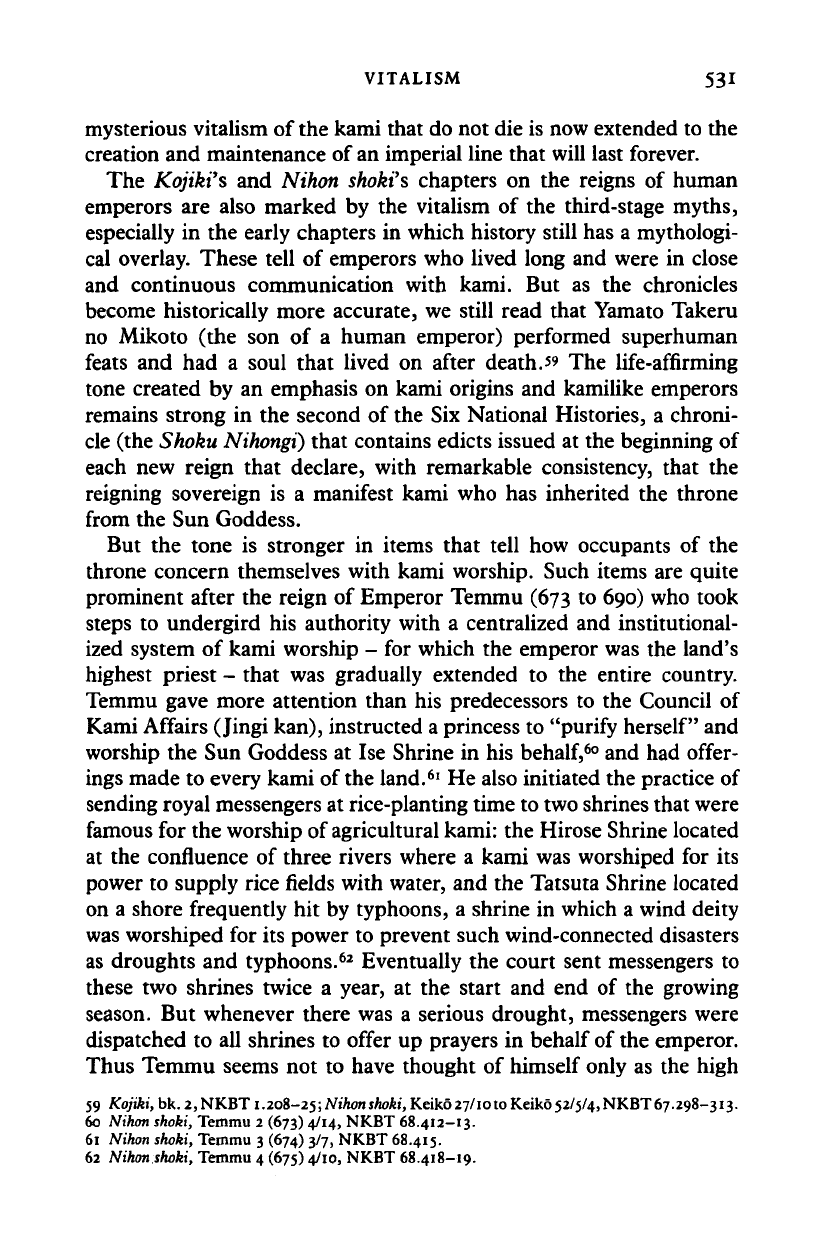
VITALISM 531
mysterious vitalism of the kami that do not die is now extended to the
creation and maintenance of an imperial line that will last forever.
The Kojiki's and Nihon shoki's chapters on the reigns of human
emperors are also marked by the vitalism of the third-stage myths,
especially in the early chapters in which history still has a mythologi-
cal overlay. These tell of emperors who lived long and were in close
and continuous communication with kami. But as the chronicles
become historically more accurate, we still read that Yamato Takeru
no Mikoto (the son of a human emperor) performed superhuman
feats and had a soul that lived on after death.& The life-affirming
tone created by an emphasis on kami origins and kamilike emperors
remains strong in the second of the Six National Histories, a chroni-
cle (the Shoku
Nihongi)
that contains edicts issued at the beginning of
each new reign that declare, with remarkable consistency, that the
reigning sovereign is a manifest kami who has inherited the throne
from the Sun Goddess.
But the tone is stronger in items that tell how occupants of the
throne concern themselves with kami worship. Such items are quite
prominent after the reign of Emperor Temmu (673 to 690) who took
steps to undergird his authority with a centralized and institutional-
ized system of kami worship - for which the emperor was the land's
highest priest - that was gradually extended to the entire country.
Temmu gave more attention than his predecessors to the Council of
Kami Affairs (Jingi kan), instructed a princess to "purify
herself"
and
worship the Sun Goddess at Ise Shrine in his
behalf,
60
and had offer-
ings made to every kami of the land.
61
He also initiated the practice of
sending royal messengers at rice-planting time to two shrines that were
famous for the worship of agricultural kami: the Hirose Shrine located
at the confluence of three rivers where a kami was worshiped for its
power to supply rice fields with water, and the Tatsuta Shrine located
on a shore frequently hit by typhoons, a shrine in which a wind deity
was worshiped for its power to prevent such wind-connected disasters
as droughts and typhoons.
62
Eventually the court sent messengers to
these two shrines twice a year, at the start and end of the growing
season. But whenever there was a serious drought, messengers were
dispatched to all shrines to offer up prayers in behalf of the emperor.
Thus Temmu seems not to have thought of himself only as the high
59 Kojiki, bk. 2, NKBT1.208-25;Nihonshoki, Keiko27/10to Keiko 52/5/4,NKBT67.298-313.
60 Nihon shoki, Temmu 2 (673) 4/14, NKBT 68.412-13.
61 Nihon shoki, Temmu 3 (674) 3/7, NKBT 68.415.
62 Nihon.shoki, Temmu 4 (675) 4/10, NKBT 68.418-19.
Cambridge Histories Online © Cambridge University Press, 2008
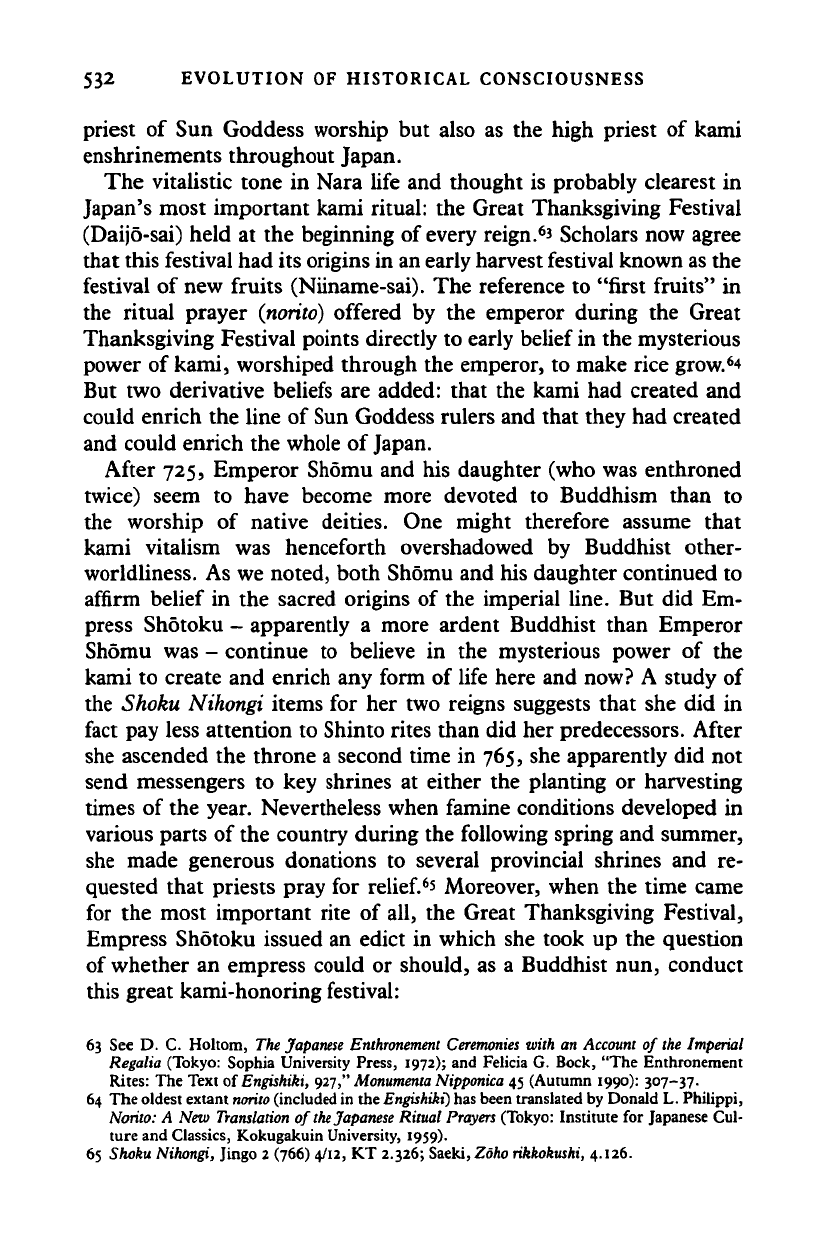
532 EVOLUTION OF HISTORICAL CONSCIOUSNESS
priest of Sun Goddess worship but also as the high priest of kami
enshrinements throughout Japan.
The vitalistic tone in Nara life and thought is probably clearest in
Japan's most important kami ritual: the Great Thanksgiving Festival
(Daijo-sai) held at the beginning of every reign.
63
Scholars now agree
that this festival had its origins in an early harvest festival known as the
festival of new fruits (Niiname-sai). The reference to "first fruits" in
the ritual prayer
(norito)
offered by the emperor during the Great
Thanksgiving Festival points directly to early belief in the mysterious
power of kami, worshiped through the emperor, to make rice grow.
6
*
But two derivative beliefs are added: that the kami had created and
could enrich the line of Sun Goddess rulers and that they had created
and could enrich the whole of Japan.
After 725, Emperor Shomu and his daughter (who was enthroned
twice) seem to have become more devoted to Buddhism than to
the worship of native deities. One might therefore assume that
kami vitalism was henceforth overshadowed by Buddhist other-
worldliness. As we noted, both Shomu and his daughter continued to
affirm belief in the sacred origins of the imperial line. But did Em-
press Shotoku - apparently a more ardent Buddhist than Emperor
Shomu was - continue to believe in the mysterious power of the
kami to create and enrich any form of life here and now? A study of
the Shoku Nihongi items for her two reigns suggests that she did in
fact pay less attention to Shinto rites than did her predecessors. After
she ascended the throne a second time in 765, she apparently did not
send messengers to key shrines at either the planting or harvesting
times of the year. Nevertheless when famine conditions developed in
various parts of the country during the following spring and summer,
she made generous donations to several provincial shrines and re-
quested that priests pray for
relief.
6
*
Moreover, when the time came
for the most important rite of all, the Great Thanksgiving Festival,
Empress Shotoku issued an edict in which she took up the question
of whether an empress could or should, as a Buddhist nun, conduct
this great kami-honoring festival:
63 See D. C. Holtom, The Japanese Enthronement Ceremonies with an Account of the Imperial
Regalia (Tokyo: Sophia University Press, 1972); and Felicia G. Bock, "The Enthronement
Rites:
The Text of Engishiki, 927," Monumenla Nipponica 45 (Autumn 1990): 307-37.
64 The oldest extant
norito
(included in the Engishiki) has been translated by Donald L. Philippi,
Norito: A New Translation of the Japanese Ritual Prayers (Tokyo: Institute for Japanese Cul-
ture and Classics, Kokugakuin University, 1959).
65 Shoku Nihongi, Jingo 2 (766) 4/12, KT 2.326; Saeki, Zoho rikkokushi, 4.126.
Cambridge Histories Online © Cambridge University Press, 2008
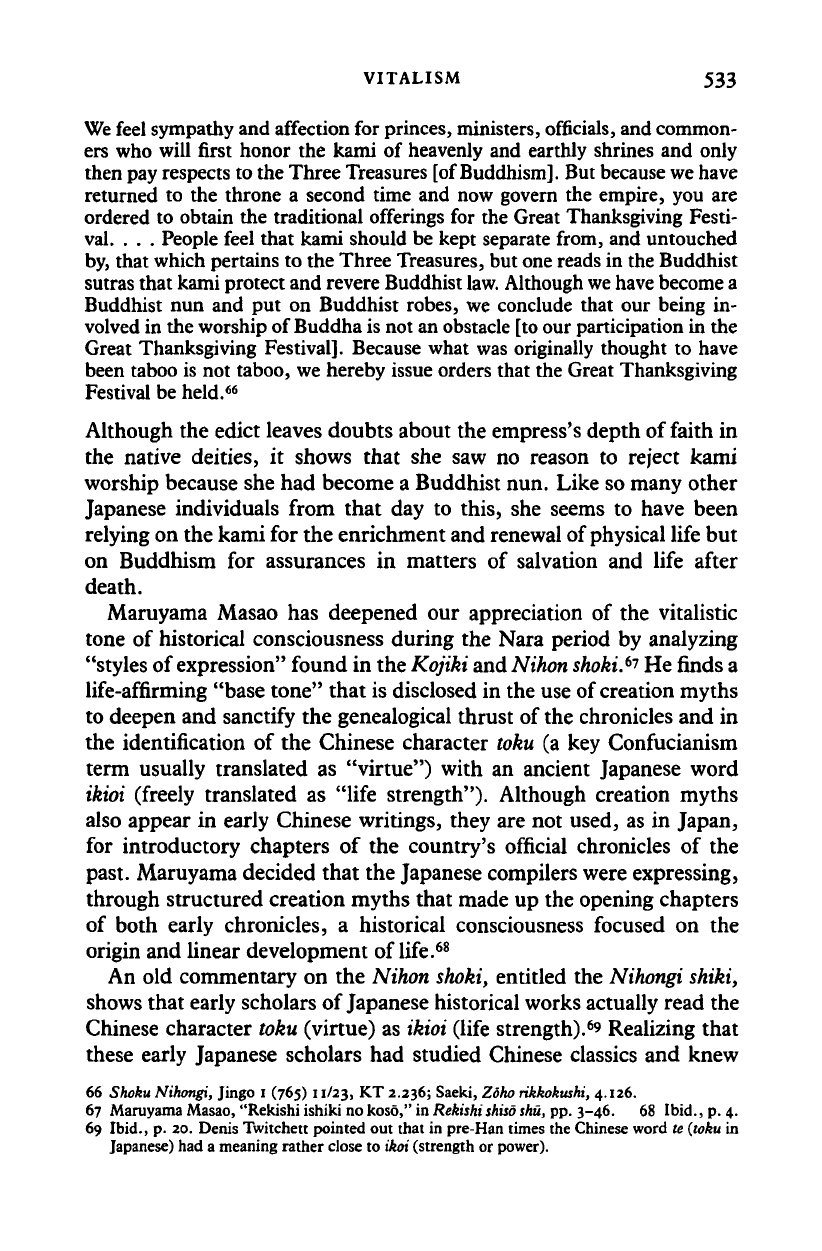
VITALISM 533
We
feel sympathy and affection for princes, ministers, officials, and common-
ers who will first honor the kami of heavenly and earthly shrines and only
then pay respects to the Three Treasures [of
Buddhism].
But because we have
returned to the throne a second time and now govern the empire, you are
ordered to obtain the traditional offerings for the Great Thanksgiving Festi-
val.
. . . People feel that kami should be kept separate from, and untouched
by, that which pertains to the Three Treasures, but one reads in the Buddhist
sutras that kami protect and revere Buddhist
law.
Although
we
have become a
Buddhist nun and put on Buddhist robes, we conclude that our being in-
volved in the worship of Buddha is not an obstacle [to our participation in the
Great Thanksgiving Festival]. Because what was originally thought to have
been taboo is not taboo, we hereby issue orders that the Great Thanksgiving
Festival be held.
66
Although the edict leaves doubts about the empress's depth of faith in
the native deities, it shows that she saw no reason to reject kami
worship because she had become a Buddhist nun. Like so many other
Japanese individuals from that day to this, she seems to have been
relying on the kami for the enrichment and renewal of physical life but
on Buddhism for assurances in matters of salvation and life after
death.
Maruyama Masao has deepened our appreciation of the vitalistic
tone of historical consciousness during the Nara period by analyzing
"styles of expression" found in the Kojiki and
Nihon
shoki.^ He finds
a
life-affirming "base tone" that is disclosed in the use of creation myths
to deepen and sanctify the genealogical thrust of the chronicles and in
the identification of the Chinese character toku (a key Confucianism
term usually translated as "virtue") with an ancient Japanese word
ikioi (freely translated as "life strength"). Although creation myths
also appear in early Chinese writings, they are not used, as in Japan,
for introductory chapters of the country's official chronicles of the
past. Maruyama decided that the Japanese compilers were expressing,
through structured creation myths that made up the opening chapters
of both early chronicles, a historical consciousness focused on the
origin and linear development of life.
68
An old commentary on the Nihon
shoki,
entitled the
Nihongi
shiki,
shows that early scholars of Japanese historical works actually read the
Chinese character toku (virtue) as ikioi (life strength).
69
Realizing that
these early Japanese scholars had studied Chinese classics and knew
66 Shoku Nihongi, Jingo I (765) 11/23, KT 2.236; Saeki, Zoho
rikkokushi,
4.126.
67 Maruyama Masao, "Rekishi ishiki no koso," in Rekishi
shisd
shu,
pp. 3-46. 68 Ibid., p. 4.
69 Ibid., p. 20. Denis Twitchett pointed out that in pre-Han times the Chinese word te (toku in
Japanese) had a meaning rather close to ikoi (strength or power).
Cambridge Histories Online © Cambridge University Press, 2008
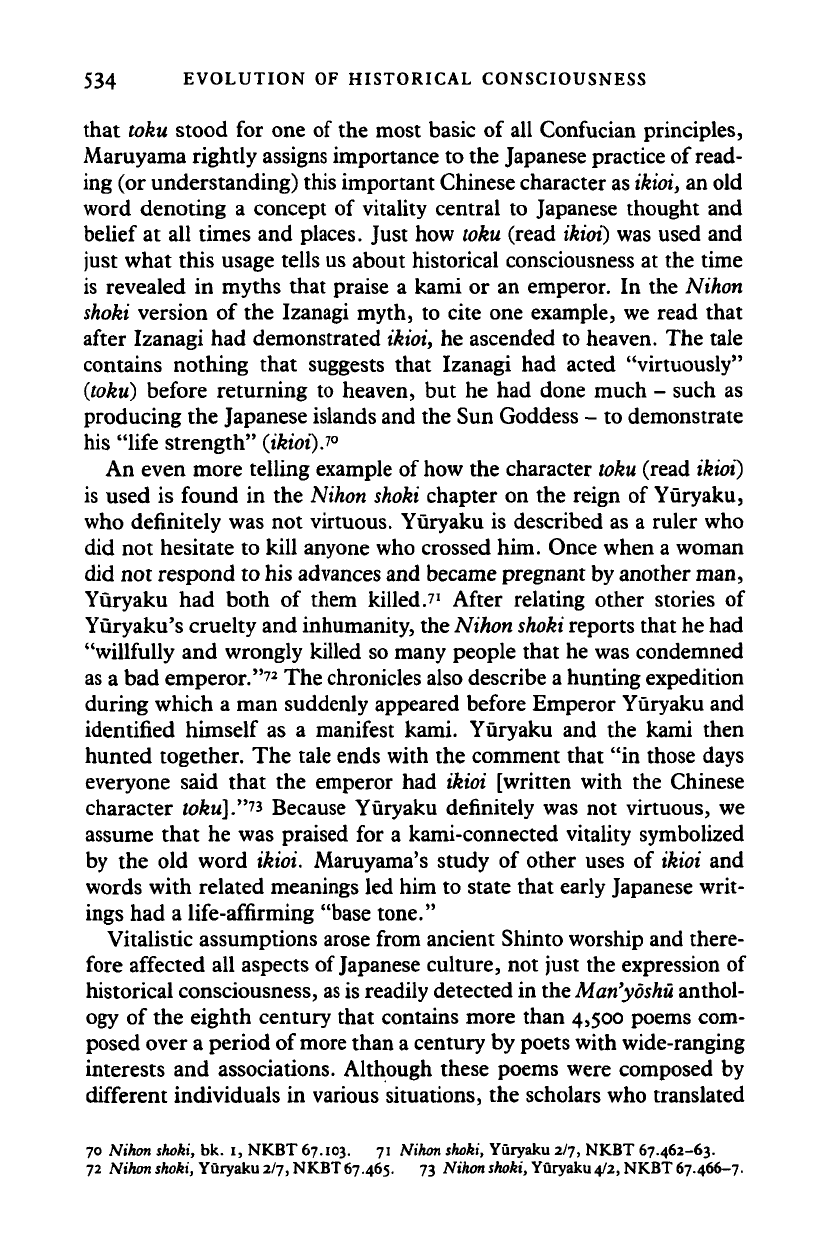
534 EVOLUTION OF HISTORICAL CONSCIOUSNESS
that toku stood for one of the most basic of all Confucian principles,
Maruyama rightly assigns importance to the Japanese practice of read-
ing (or understanding) this important Chinese character as
ikioi,
an old
word denoting a concept of vitality central to Japanese thought and
belief at all times and places. Just how toku (read
ikioi)
was used and
just what this usage tells us about historical consciousness at the time
is revealed in myths that praise a kami or an emperor. In the Nihon
shoki version of the Izanagi myth, to cite one example, we read that
after Izanagi had demonstrated
ikioi,
he ascended to heaven. The tale
contains nothing that suggests that Izanagi had acted "virtuously"
(toku) before returning to heaven, but he had done much - such as
producing the Japanese islands and the Sun Goddess - to demonstrate
his "life strength"
(ikioi)J°
An even more telling example of how the character
toku
(read ikioi)
is used is found in the Nihon
shoki
chapter on the reign of Yuryaku,
who definitely was not virtuous. Yuryaku is described as a ruler who
did not hesitate to kill anyone who crossed him. Once when a woman
did not respond to his advances and became pregnant by another man,
Yuryaku had both of them killed.
71
After relating other stories of
Yuryaku's cruelty and inhumanity, the Nihon
shoki
reports that he had
"willfully and wrongly killed so many people that he was condemned
as a bad emperor."
72
The chronicles also describe a hunting expedition
during which a man suddenly appeared before Emperor Yuryaku and
identified himself as a manifest kami. Yuryaku and the kami then
hunted together. The tale ends with the comment that "in those days
everyone said that the emperor had ikioi [written with the Chinese
character tofew]."
73
Because Yuryaku definitely was not virtuous, we
assume that he was praised for a kami-connected vitality symbolized
by the old word ikioi. Maruyama's study of other uses of ikioi and
words with related meanings led him to state that early Japanese writ-
ings had a life-affirming "base tone."
Vitalistic assumptions arose from ancient Shinto worship and there-
fore affected all aspects of Japanese culture, not just the expression of
historical consciousness,
as
is readily detected in
the Man'yoshu
anthol-
ogy of the eighth century that contains more than 4,500 poems com-
posed over a period of
more
than a century by poets with wide-ranging
interests and associations. Although these poems were composed by
different individuals in various situations, the scholars who translated
70 Nihon shoki, bk. I, NKBT 67.103. 71 Nihon shoki, Yuryaku 2/7, NKBT 67.462-63.
72 Nihon shoki, Yuryaku 2/7, NKBT67.465. 73 Nihon shoki, Yuryaku 4/2, NKBT 67.466-7.
Cambridge Histories Online © Cambridge University Press, 2008
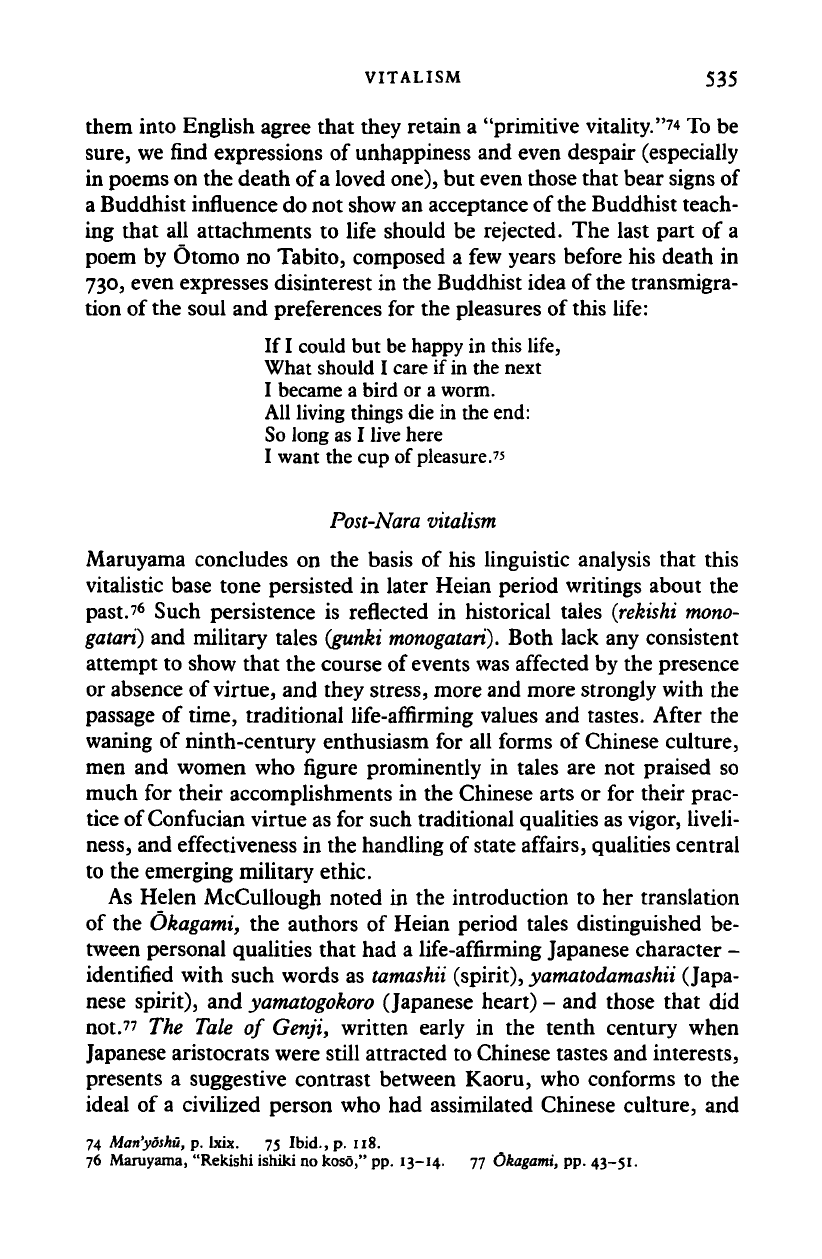
VITALISM 535
them into English agree that they retain a "primitive vitality."
74
To be
sure,
we find expressions of unhappiness and even despair (especially
in poems on the death of a loved one), but even those that bear signs of
a Buddhist influence do not show an acceptance of the Buddhist teach-
ing that all attachments to life should be rejected. The last part of a
poem by Otomo no Tabito, composed a few years before his death in
730,
even expresses disinterest in the Buddhist idea of the transmigra-
tion of the soul and preferences for the pleasures of this life:
If I could but be happy in this life,
What should I care if
in
the next
I became a bird or a worm.
All living things die in the end:
So long as I live here
I want the cup of pleasure."
Post-Nara vitalism
Maruyama concludes on the basis of his linguistic analysis that this
vitalistic base tone persisted in later Heian period writings about the
past.
76
Such persistence is reflected in historical tales (rekishi mono-
gatari) and military tales (gunki
monogatari).
Both lack any consistent
attempt to show that the course of events was affected by the presence
or absence of virtue, and they stress, more and more strongly with the
passage of time, traditional life-affirming values and tastes. After the
waning of ninth-century enthusiasm for all forms of Chinese culture,
men and women who figure prominently in tales are not praised so
much for their accomplishments in the Chinese arts or for their prac-
tice of Confucian virtue as for such traditional qualities as vigor, liveli-
ness,
and effectiveness in the handling of state affairs, qualities central
to the emerging military ethic.
As Helen McCullough noted in the introduction to her translation
of the Okagami, the authors of Heian period tales distinguished be-
tween personal qualities that had a life-affirming Japanese character -
identified with such words as tamashii (spirit), yamatodamashii (Japa-
nese spirit), and yamatogokoro (Japanese heart) - and those that did
not.
77
The Tale of Genji, written early in the tenth century when
Japanese aristocrats were still attracted to Chinese tastes and interests,
presents a suggestive contrast between Kaoru, who conforms to the
ideal of a civilized person who had assimilated Chinese culture, and
74 Man'yoshu, p. lxix. 75 Ibid., p. 118.
76 Maruyama, "Rekishi ishiki no koso," pp. 13-14. 77 Okagami, pp.
43-51.
Cambridge Histories Online © Cambridge University Press, 2008
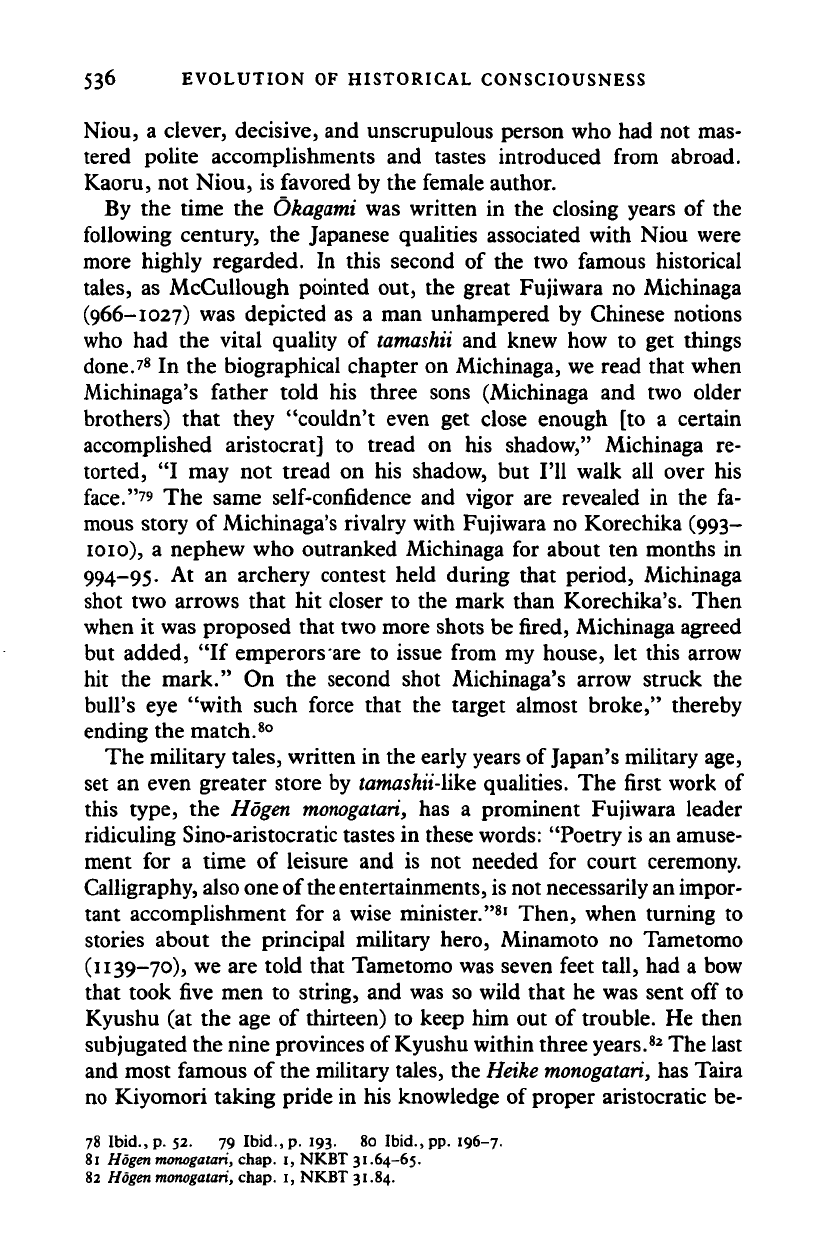
536 EVOLUTION OF HISTORICAL CONSCIOUSNESS
Niou, a clever, decisive, and unscrupulous person who had not mas-
tered polite accomplishments and tastes introduced from abroad.
Kaoru, not Niou, is favored by the female author.
By the time the Okagami was written in the closing years of the
following century, the Japanese qualities associated with Niou were
more highly regarded. In this second of the two famous historical
tales,
as McCullough pointed out, the great Fujiwara no Michinaga
(966-1027) was depicted as a man unhampered by Chinese notions
who had the vital quality of
tamashii
and knew how to get things
done.
78
In the biographical chapter on Michinaga, we read that when
Michinaga's father told his three sons (Michinaga and two older
brothers) that they "couldn't even get close enough [to a certain
accomplished aristocrat] to tread on his shadow," Michinaga re-
torted, "I may not tread on his shadow, but I'll walk all over his
face."
79
The same self-confidence and vigor are revealed in the fa-
mous story of Michinaga's rivalry with Fujiwara no Korechika (993-
1010),
a nephew who outranked Michinaga for about ten months in
994-95.
At an archery contest held during that period, Michinaga
shot two arrows that hit closer to the mark than Korechika's. Then
when it was proposed that two more shots be fired, Michinaga agreed
but added, "If emperors are to issue from my house, let this arrow
hit the mark." On the second shot Michinaga's arrow struck the
bull's eye "with such force that the target almost broke," thereby
ending the match.
80
The military tales, written in the early years of Japan's military age,
set an even greater store by
tamashii-like
qualities. The first work of
this type, the Hogen
monogatari,
has a prominent Fujiwara leader
ridiculing Sino-aristocratic tastes in these words: "Poetry is an amuse-
ment for a time of leisure and is not needed for court ceremony.
Calligraphy, also one of the entertainments, is not necessarily an impor-
tant accomplishment for a wise minister."
81
Then, when turning to
stories about the principal military hero, Minamoto no Tametomo
(1139-70), we are told that Tametomo was seven feet tall, had a bow
that took five men to string, and was so wild that he was sent off to
Kyushu (at the age of thirteen) to keep him out of trouble. He then
subjugated the nine provinces of Kyushu within three years.
82
The last
and most famous of the military tales, the
Heike
monogatari,
has Taira
no Kiyomori taking pride in his knowledge of proper aristocratic be-
78 Ibid., p. 52. 79 Ibid., p. 193. 80 Ibid., pp. 196-7.
81 Hogen monogatari, chap. 1, NKBT 31.64-65.
82 Hogen monogatari, chap. 1, NKBT 31.84.
Cambridge Histories Online © Cambridge University Press, 2008
